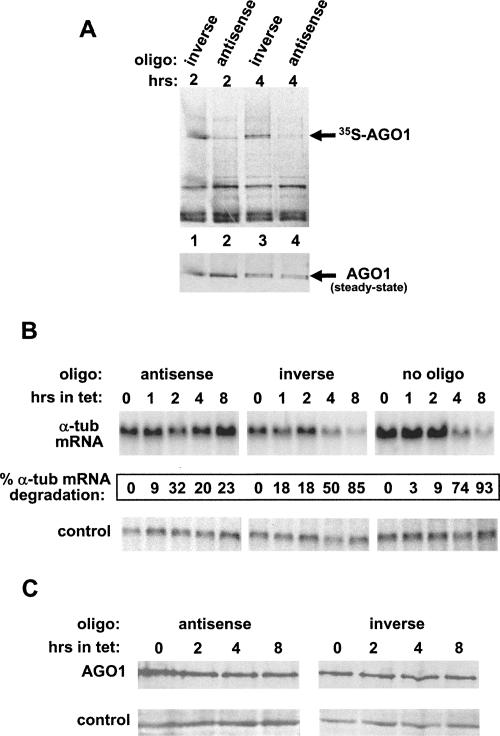FIGURE 5.
(A) Transfection of a morpholino antisense oligonucleotide inhibits accumulation of newly synthesized TbAGO1. Cells solely expressing BB2-TAP-tagged TbAGO1 were transfected with an AGO1 antisense morpholino oligonucleotide or with an oligonucleotide with the inverse sequence as a negative control (for details, see Materials and Methods). Four hours after transfection, the cells were metabolically labeled with 35S-methionine for 2 or 4 h, and cytoplasmic extracts were prepared and immunoprecipitated with anti-BB2 antibodies. The immunoprecipitates were separated by SDS-PAGE and the radioactive bands detected by autoradiography (upper panel). The same membrane was reacted with anti-AGO1 antibodies to verify the efficiency of immunoprecipitation (lower panel). (B) Transfection with the AGO1 antisense morpholino oligonucleotide inhibits degradation of α-tubulin mRNA. A trypanosomes cell line conditionally expressing α-tubulin dsRNA, pLEWFAT (Shi et al. 2000), was used for this analysis. Cells were transfected with the AGO1 antisense or inverse morpholino oligonucleotide, or mock-transfected (no oligo), and grown for the periods of time indicated above each lane in medium containing 10 μg/mL tet, which induces maximal synthesis of α-tubulin dsRNA. At each time point, RNA was extracted and analyzed by Northern blotting with an α-tubulin coding-region probe or with a control probe for actin mRNA. The percent α-tubulin mRNA degradation was calculated as described in the legend to Figure 2. (B) The steady-state level of TbAGO1 does not significantly change upon transfection with morpholino oligonucleotides. pLEWFAT cells were transfected with the indicated morpholino oligonucleotides and grown in the presence of tet as described above. Samples were withdrawn at various intervals (indicated above each lane) and processed for Western blot analysis with anti-AGO1 antibodies. Control indicates a cross-reacting protein.

